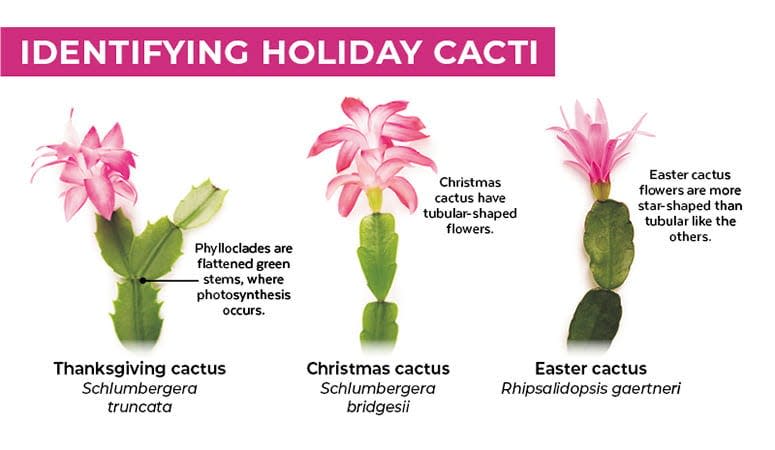Gardening: Christmas cactus often confused with its Thanksgiving kin - learn the difference

A gardener recently asked me why her Christmas cactus bloomed before Thanksgiving. My short answer was that it was likely a Thanksgiving cactus, which normally blooms between Halloween and Thanksgiving. I then asked the gardener what the shape of the leafy stems of her cacti looked like—whether they had three or four sharp points on each side with a jagged appearance, or more rounded, teardrop-like indentations. When the gardener indicated that the leafy stems of her cactus had a more jagged edge, it was confirmation that her plant was a Thanksgiving cactus, not a Christmas cactus. There is also an Easter cactus which blooms in spring!
Many plants sold as Christmas cactus at this time of the year are not Christmas cactus at all. And many of these plants, which I like to call holiday cacti, are passed down from one generation to the next as family heirlooms because they are plants which live a long time—some up to 100 years! So, it’s not uncommon for someone to own a holiday cactus with an unknown pedigree.

Gardening: What to look for when seeking the perfect live Christmas tree
Holiday cacti basics
All three of these holiday cacti are easy-to-grow houseplants that are native to the rainforest of Brazil, not to the desert with which we typically associate most species of cacti. These plants are actually succulents, not true cacti. The Thanksgiving cactus (Schlumbergera truncate) blooms from late October through November while Christmas cactus (Schlumbergera bridgesii) blooms from late November through late January. The Easter cactus (Hatiora gaertneri) only blooms in the spring. Complicating this understanding of holiday cacti bloom schedules is the fact that sometimes Thanksgiving and Christmas cacti will bloom a second time in the spring!
Identifying holiday cacti
The best method for identifying which holiday cactus you own is to examine the shape of its leaves, which are not true leaves but modified stems called phylloclades and cladophylls. These flattened, pad-like stems are segmented, almost like the links of a chain. Each of the three different holiday cacti have differently shaped stems.
Thanksgiving cactus stem segments have two to four sharp points on each side, giving the stem a jagged-appearing edge. The stem segments on a Christmas cactus have more rounded teardrop indentations. And Easter cactus stem segments are more oval in shape with rounded indentations.

Blossoms on each type of holiday cacti are also different. Thanksgiving cactus flowers are asymmetrical and hang down from stems that arch downward, although the flowers present more horizontally. The flowers on Christmas cactus are more symmetrical in shape and present more vertically. Easter cactus flowers are flatter star-shaped and tend to point upward.
Holiday cacti flowers can be red, pink, peach, yellow, purple, fuchsia, salmon, orange or white. The flowers typically last for a few weeks. Easter cacti typically have more vibrant colors than Christmas or Thanksgiving cacti. Miniature varieties of Christmas cacti also exist.
Caring for holiday cacti
All of these holiday cacti prefer rich, porous, acid soil, as they are epiphytes, which means that in their native habitat they grow on other plants, typically in the areas where branches meet, or in other indentations of branches or the trunk of a tree. In their native habitat, these plants obtain moisture from air and rain and nutrients from decaying leaves and plant debris.
Gardening: Make your home decor merry and bright by adding some holiday flowers
As houseplants, the soil for these plants should be kept evenly moist and should be allowed to dry out between watering. Holiday cacti should be kept in a bright location, but out of direct sunlight. Holiday cacti will benefit from frequent misting of the foliage, especially in winter when interior spaces typically have a lower level of humidity.
Similar to poinsettias, holiday cacti are short-day plants, which means that they require cool overnight temperatures between 60 and 65 degrees Fahrenheit and 12 hours of complete darkness each day for several weeks before they will bloom. The plants can be pruned after they bloom to make them fuller. Holiday cacti seem to do best when they are somewhat root-bound, so don’t be too quick to repot holiday cacti into larger pots.
No matter which holiday cactus you own, these plants provide a pop of color inside the home at a time of the year when few other plants are in bloom, so enjoy the color whether it arrives around Christmas, Thanksgiving or Easter!
Mike Hogan is an Extension educator, Agriculture and Natural Resources, and associate professor with The Ohio State University Extension.
This article originally appeared on The Columbus Dispatch: Learn to identify, care for Christmas, Thanksgiving and Easter cacti

